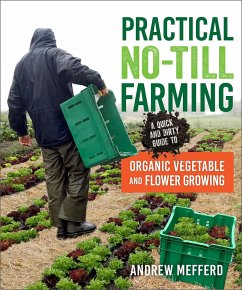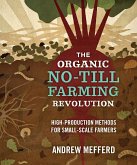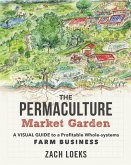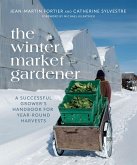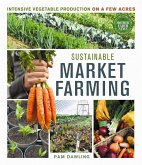Andrew Mefferd
Practical No-Till Farming
A Quick and Dirty Guide to Organic Vegetable and Flower Growing
Andrew Mefferd
Practical No-Till Farming
A Quick and Dirty Guide to Organic Vegetable and Flower Growing
- Broschiertes Buch
- Merkliste
- Auf die Merkliste
- Bewerten Bewerten
- Teilen
- Produkt teilen
- Produkterinnerung
- Produkterinnerung
Practical No-Till Farming is the ultimate guide to getting started with organic no-till growing methods. Coverage includes pros and cons of different no-till methods, customizing no-till for your farm, detailed how-to for each method, relative costs, handling pernicious weeds, and boosting soil health and crop yield.
Andere Kunden interessierten sich auch für
![The Organic No-Till Farming Revolution The Organic No-Till Farming Revolution]() Andrew MefferdThe Organic No-Till Farming Revolution33,99 €
Andrew MefferdThe Organic No-Till Farming Revolution33,99 €![The Permaculture Market Garden The Permaculture Market Garden]() Zach LoeksThe Permaculture Market Garden40,99 €
Zach LoeksThe Permaculture Market Garden40,99 €![The Winter Market Gardener The Winter Market Gardener]() Jean-Martin FortierThe Winter Market Gardener37,99 €
Jean-Martin FortierThe Winter Market Gardener37,99 €![Sustainable Market Farming Sustainable Market Farming]() Pam DawlingSustainable Market Farming38,99 €
Pam DawlingSustainable Market Farming38,99 €![The Soil and Health The Soil and Health]() Albert HowardThe Soil and Health18,99 €
Albert HowardThe Soil and Health18,99 €![The Intelligent Gardener The Intelligent Gardener]() Steve SolomonThe Intelligent Gardener23,99 €
Steve SolomonThe Intelligent Gardener23,99 €![DIY Mushroom Cultivation DIY Mushroom Cultivation]() Willoughby ArevaloDIY Mushroom Cultivation30,99 €
Willoughby ArevaloDIY Mushroom Cultivation30,99 €-
-
-
Practical No-Till Farming is the ultimate guide to getting started with organic no-till growing methods. Coverage includes pros and cons of different no-till methods, customizing no-till for your farm, detailed how-to for each method, relative costs, handling pernicious weeds, and boosting soil health and crop yield.
Hinweis: Dieser Artikel kann nur an eine deutsche Lieferadresse ausgeliefert werden.
Hinweis: Dieser Artikel kann nur an eine deutsche Lieferadresse ausgeliefert werden.
Produktdetails
- Produktdetails
- Verlag: New Society Publishers
- Seitenzahl: 240
- Erscheinungstermin: 1. November 2022
- Englisch
- Abmessung: 226mm x 188mm x 15mm
- Gewicht: 534g
- ISBN-13: 9780865719668
- ISBN-10: 0865719667
- Artikelnr.: 63333097
- Herstellerkennzeichnung
- Libri GmbH
- Europaallee 1
- 36244 Bad Hersfeld
- gpsr@libri.de
- Verlag: New Society Publishers
- Seitenzahl: 240
- Erscheinungstermin: 1. November 2022
- Englisch
- Abmessung: 226mm x 188mm x 15mm
- Gewicht: 534g
- ISBN-13: 9780865719668
- ISBN-10: 0865719667
- Artikelnr.: 63333097
- Herstellerkennzeichnung
- Libri GmbH
- Europaallee 1
- 36244 Bad Hersfeld
- gpsr@libri.de
Andrew Mefferd is the editor of Growing for Market magazine and author of The Organic No-Till Farming Revolution and The Greenhouse and Hoophouse Grower's Handbook. He spent seven years in the research department at Johnny's Selected Seeds, traveling internationally consulting with researchers and farmers on the best practices in organic farming. Before that he worked on the research farm at Virginia Tech, doing field work researching how organic no-till vegetable production compared to tilled organic production. He has worked on farms in Pennsylvania, California, Washington State, Virginia, Maine, and New York State. He now farms in Cornville, Maine.
Part 1: The Why of No-Till
INTRODUCTION
Who This Book Is For
Tilling Was Once the Only Answer
Enthusiasm and Skepticism for No-Till
Becoming a No-Till Farmer
Defining No-Till: What Counts as Tillage Anyway?
New Adaptation for Old Methods
The Promise of No-Till
THE POWER OF THE SOIL
Putting a Face on the Soil
Soil: Where the Microbe Magic Happens
Taking Care of Our Livestock
Soil Life Drives the Success of No-Till Systems
Soil Testing
Healthy Soil Can Lead to Healthier Farmers
FARM SIZE
Farming as a Career
NO-TILL: A GATEWAY METHOD
Evolution of Your Farm
Small Can Be Beautiful
NO-TILL VS. TILLAGE
Tillage: The Agricultural Reset Button
Tillage: An Ancient Practice We Might Want to Avoid
THE DISADVANTAGES OF TILLING
Breakdown in the Nutrient Cycle
Weeds
Hard Work and Time-Consuming
Physical, Chemical, and Biological Disadvantages
THE ADVANTAGES OF NO-TILL
Advantages for the Environment
Fungus: The Perennial Roots of the Soil
Soil and Water Can Do Their Jobs
Increase in Organic Matter
Advantages for Growers
THE DISADVANTAGES OF NO-TILL
Fields Are Slower to Warm in Spring
Systems Can Take Some Time to Become Established
Some Methods Are Hard to Scale Up
Some Pests Can Flourish in High Residue
Perennial Weeds
Part 2: The How of No-Till
GETTING STARTED: PRINCIPLES, TECHNIQUES, AND TOOLS
Start with a Soil Test
Clearing the Deck: Getting the Soil Ready
Establishing New Fields
Sod Bustin', No-Till Style
Reduce the Weed Seed Bank First
TARPING
Occultation
Solarization
Tarp Timing
Decomposition Rates
IT'S ALL ABOUT THE MULCHES
Non-Decomposing Mulches
Applied Organic Mulches
MULCH GROWN IN PLACE
The Roller/Crimper Method
Roller/Crimper Cons
Winter-Killed Cover Mulch Crops
Planting through a Cover Crop Mulch
Which Crops Work Best in the Roller/Crimper System?
GETTING STARTED AND CROPPING STRATEGIES
Composting in Place
Compost as Mulch
Ways to Improve Land and Exhaust the Weed Seed Bank
CROPS TO FOCUS ON
GOING FROM CROP TO CROP
Dealing with Residue
Planting
Flowers in No-Till
CASE STUDY: GROWING HEMP
APPENDIX
NOTES
BIBLIOGRAPHY
INDEX
ABOUT THE AUTHOR
ABOUT THE PUBLISHER
INTRODUCTION
Who This Book Is For
Tilling Was Once the Only Answer
Enthusiasm and Skepticism for No-Till
Becoming a No-Till Farmer
Defining No-Till: What Counts as Tillage Anyway?
New Adaptation for Old Methods
The Promise of No-Till
THE POWER OF THE SOIL
Putting a Face on the Soil
Soil: Where the Microbe Magic Happens
Taking Care of Our Livestock
Soil Life Drives the Success of No-Till Systems
Soil Testing
Healthy Soil Can Lead to Healthier Farmers
FARM SIZE
Farming as a Career
NO-TILL: A GATEWAY METHOD
Evolution of Your Farm
Small Can Be Beautiful
NO-TILL VS. TILLAGE
Tillage: The Agricultural Reset Button
Tillage: An Ancient Practice We Might Want to Avoid
THE DISADVANTAGES OF TILLING
Breakdown in the Nutrient Cycle
Weeds
Hard Work and Time-Consuming
Physical, Chemical, and Biological Disadvantages
THE ADVANTAGES OF NO-TILL
Advantages for the Environment
Fungus: The Perennial Roots of the Soil
Soil and Water Can Do Their Jobs
Increase in Organic Matter
Advantages for Growers
THE DISADVANTAGES OF NO-TILL
Fields Are Slower to Warm in Spring
Systems Can Take Some Time to Become Established
Some Methods Are Hard to Scale Up
Some Pests Can Flourish in High Residue
Perennial Weeds
Part 2: The How of No-Till
GETTING STARTED: PRINCIPLES, TECHNIQUES, AND TOOLS
Start with a Soil Test
Clearing the Deck: Getting the Soil Ready
Establishing New Fields
Sod Bustin', No-Till Style
Reduce the Weed Seed Bank First
TARPING
Occultation
Solarization
Tarp Timing
Decomposition Rates
IT'S ALL ABOUT THE MULCHES
Non-Decomposing Mulches
Applied Organic Mulches
MULCH GROWN IN PLACE
The Roller/Crimper Method
Roller/Crimper Cons
Winter-Killed Cover Mulch Crops
Planting through a Cover Crop Mulch
Which Crops Work Best in the Roller/Crimper System?
GETTING STARTED AND CROPPING STRATEGIES
Composting in Place
Compost as Mulch
Ways to Improve Land and Exhaust the Weed Seed Bank
CROPS TO FOCUS ON
GOING FROM CROP TO CROP
Dealing with Residue
Planting
Flowers in No-Till
CASE STUDY: GROWING HEMP
APPENDIX
NOTES
BIBLIOGRAPHY
INDEX
ABOUT THE AUTHOR
ABOUT THE PUBLISHER
Part 1: The Why of No-Till
INTRODUCTION
Who This Book Is For
Tilling Was Once the Only Answer
Enthusiasm and Skepticism for No-Till
Becoming a No-Till Farmer
Defining No-Till: What Counts as Tillage Anyway?
New Adaptation for Old Methods
The Promise of No-Till
THE POWER OF THE SOIL
Putting a Face on the Soil
Soil: Where the Microbe Magic Happens
Taking Care of Our Livestock
Soil Life Drives the Success of No-Till Systems
Soil Testing
Healthy Soil Can Lead to Healthier Farmers
FARM SIZE
Farming as a Career
NO-TILL: A GATEWAY METHOD
Evolution of Your Farm
Small Can Be Beautiful
NO-TILL VS. TILLAGE
Tillage: The Agricultural Reset Button
Tillage: An Ancient Practice We Might Want to Avoid
THE DISADVANTAGES OF TILLING
Breakdown in the Nutrient Cycle
Weeds
Hard Work and Time-Consuming
Physical, Chemical, and Biological Disadvantages
THE ADVANTAGES OF NO-TILL
Advantages for the Environment
Fungus: The Perennial Roots of the Soil
Soil and Water Can Do Their Jobs
Increase in Organic Matter
Advantages for Growers
THE DISADVANTAGES OF NO-TILL
Fields Are Slower to Warm in Spring
Systems Can Take Some Time to Become Established
Some Methods Are Hard to Scale Up
Some Pests Can Flourish in High Residue
Perennial Weeds
Part 2: The How of No-Till
GETTING STARTED: PRINCIPLES, TECHNIQUES, AND TOOLS
Start with a Soil Test
Clearing the Deck: Getting the Soil Ready
Establishing New Fields
Sod Bustin', No-Till Style
Reduce the Weed Seed Bank First
TARPING
Occultation
Solarization
Tarp Timing
Decomposition Rates
IT'S ALL ABOUT THE MULCHES
Non-Decomposing Mulches
Applied Organic Mulches
MULCH GROWN IN PLACE
The Roller/Crimper Method
Roller/Crimper Cons
Winter-Killed Cover Mulch Crops
Planting through a Cover Crop Mulch
Which Crops Work Best in the Roller/Crimper System?
GETTING STARTED AND CROPPING STRATEGIES
Composting in Place
Compost as Mulch
Ways to Improve Land and Exhaust the Weed Seed Bank
CROPS TO FOCUS ON
GOING FROM CROP TO CROP
Dealing with Residue
Planting
Flowers in No-Till
CASE STUDY: GROWING HEMP
APPENDIX
NOTES
BIBLIOGRAPHY
INDEX
ABOUT THE AUTHOR
ABOUT THE PUBLISHER
INTRODUCTION
Who This Book Is For
Tilling Was Once the Only Answer
Enthusiasm and Skepticism for No-Till
Becoming a No-Till Farmer
Defining No-Till: What Counts as Tillage Anyway?
New Adaptation for Old Methods
The Promise of No-Till
THE POWER OF THE SOIL
Putting a Face on the Soil
Soil: Where the Microbe Magic Happens
Taking Care of Our Livestock
Soil Life Drives the Success of No-Till Systems
Soil Testing
Healthy Soil Can Lead to Healthier Farmers
FARM SIZE
Farming as a Career
NO-TILL: A GATEWAY METHOD
Evolution of Your Farm
Small Can Be Beautiful
NO-TILL VS. TILLAGE
Tillage: The Agricultural Reset Button
Tillage: An Ancient Practice We Might Want to Avoid
THE DISADVANTAGES OF TILLING
Breakdown in the Nutrient Cycle
Weeds
Hard Work and Time-Consuming
Physical, Chemical, and Biological Disadvantages
THE ADVANTAGES OF NO-TILL
Advantages for the Environment
Fungus: The Perennial Roots of the Soil
Soil and Water Can Do Their Jobs
Increase in Organic Matter
Advantages for Growers
THE DISADVANTAGES OF NO-TILL
Fields Are Slower to Warm in Spring
Systems Can Take Some Time to Become Established
Some Methods Are Hard to Scale Up
Some Pests Can Flourish in High Residue
Perennial Weeds
Part 2: The How of No-Till
GETTING STARTED: PRINCIPLES, TECHNIQUES, AND TOOLS
Start with a Soil Test
Clearing the Deck: Getting the Soil Ready
Establishing New Fields
Sod Bustin', No-Till Style
Reduce the Weed Seed Bank First
TARPING
Occultation
Solarization
Tarp Timing
Decomposition Rates
IT'S ALL ABOUT THE MULCHES
Non-Decomposing Mulches
Applied Organic Mulches
MULCH GROWN IN PLACE
The Roller/Crimper Method
Roller/Crimper Cons
Winter-Killed Cover Mulch Crops
Planting through a Cover Crop Mulch
Which Crops Work Best in the Roller/Crimper System?
GETTING STARTED AND CROPPING STRATEGIES
Composting in Place
Compost as Mulch
Ways to Improve Land and Exhaust the Weed Seed Bank
CROPS TO FOCUS ON
GOING FROM CROP TO CROP
Dealing with Residue
Planting
Flowers in No-Till
CASE STUDY: GROWING HEMP
APPENDIX
NOTES
BIBLIOGRAPHY
INDEX
ABOUT THE AUTHOR
ABOUT THE PUBLISHER

